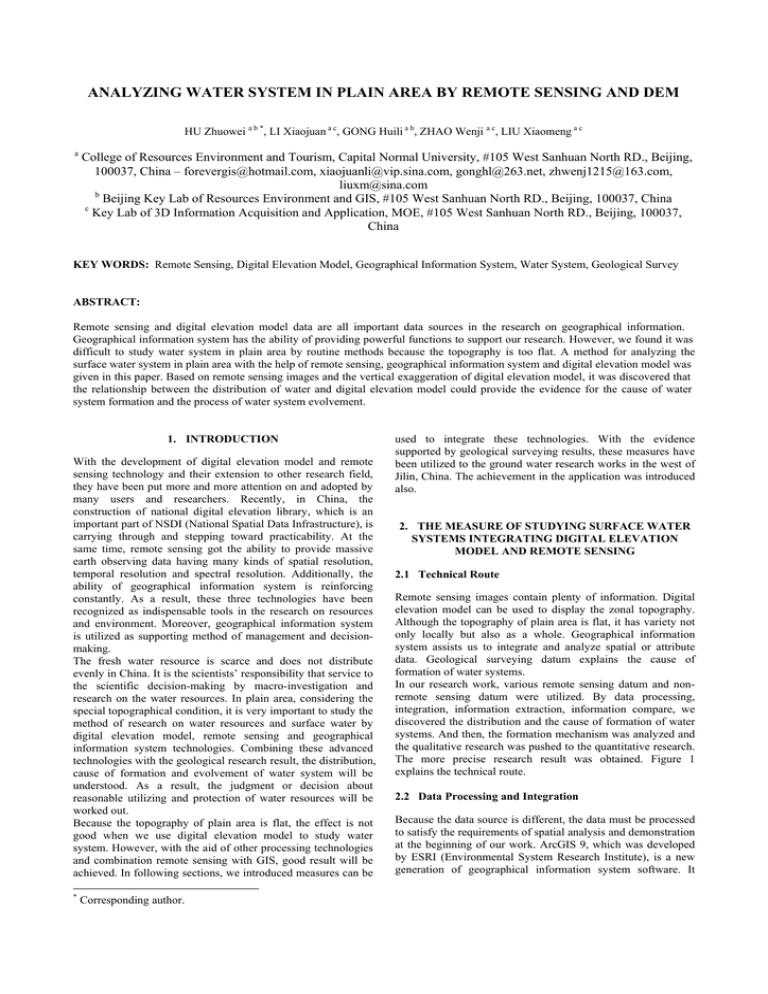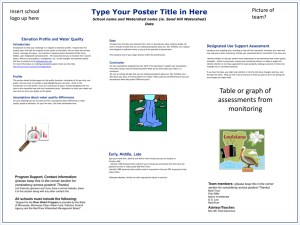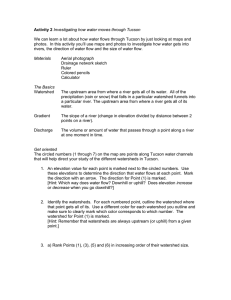ANALYZING WATER SYSTEM IN PLAIN AREA BY REMOTE SENSING AND...
advertisement

ANALYZING WATER SYSTEM IN PLAIN AREA BY REMOTE SENSING AND DEM HU Zhuowei a b *, LI Xiaojuan a c, GONG Huili a b, ZHAO Wenji a c, LIU Xiaomeng a c a College of Resources Environment and Tourism, Capital Normal University, #105 West Sanhuan North RD., Beijing, 100037, China – forevergis@hotmail.com, xiaojuanli@vip.sina.com, gonghl@263.net, zhwenj1215@163.com, liuxm@sina.com b Beijing Key Lab of Resources Environment and GIS, #105 West Sanhuan North RD., Beijing, 100037, China c Key Lab of 3D Information Acquisition and Application, MOE, #105 West Sanhuan North RD., Beijing, 100037, China KEY WORDS: Remote Sensing, Digital Elevation Model, Geographical Information System, Water System, Geological Survey ABSTRACT: Remote sensing and digital elevation model data are all important data sources in the research on geographical information. Geographical information system has the ability of providing powerful functions to support our research. However, we found it was difficult to study water system in plain area by routine methods because the topography is too flat. A method for analyzing the surface water system in plain area with the help of remote sensing, geographical information system and digital elevation model was given in this paper. Based on remote sensing images and the vertical exaggeration of digital elevation model, it was discovered that the relationship between the distribution of water and digital elevation model could provide the evidence for the cause of water system formation and the process of water system evolvement. 1. INTRODUCTION With the development of digital elevation model and remote sensing technology and their extension to other research field, they have been put more and more attention on and adopted by many users and researchers. Recently, in China, the construction of national digital elevation library, which is an important part of NSDI (National Spatial Data Infrastructure), is carrying through and stepping toward practicability. At the same time, remote sensing got the ability to provide massive earth observing data having many kinds of spatial resolution, temporal resolution and spectral resolution. Additionally, the ability of geographical information system is reinforcing constantly. As a result, these three technologies have been recognized as indispensable tools in the research on resources and environment. Moreover, geographical information system is utilized as supporting method of management and decisionmaking. The fresh water resource is scarce and does not distribute evenly in China. It is the scientists’ responsibility that service to the scientific decision-making by macro-investigation and research on the water resources. In plain area, considering the special topographical condition, it is very important to study the method of research on water resources and surface water by digital elevation model, remote sensing and geographical information system technologies. Combining these advanced technologies with the geological research result, the distribution, cause of formation and evolvement of water system will be understood. As a result, the judgment or decision about reasonable utilizing and protection of water resources will be worked out. Because the topography of plain area is flat, the effect is not good when we use digital elevation model to study water system. However, with the aid of other processing technologies and combination remote sensing with GIS, good result will be achieved. In following sections, we introduced measures can be * Corresponding author. used to integrate these technologies. With the evidence supported by geological surveying results, these measures have been utilized to the ground water research works in the west of Jilin, China. The achievement in the application was introduced also. 2. THE MEASURE OF STUDYING SURFACE WATER SYSTEMS INTEGRATING DIGITAL ELEVATION MODEL AND REMOTE SENSING 2.1 Technical Route Remote sensing images contain plenty of information. Digital elevation model can be used to display the zonal topography. Although the topography of plain area is flat, it has variety not only locally but also as a whole. Geographical information system assists us to integrate and analyze spatial or attribute data. Geological surveying datum explains the cause of formation of water systems. In our research work, various remote sensing datum and nonremote sensing datum were utilized. By data processing, integration, information extraction, information compare, we discovered the distribution and the cause of formation of water systems. And then, the formation mechanism was analyzed and the qualitative research was pushed to the quantitative research. The more precise research result was obtained. Figure 1 explains the technical route. 2.2 Data Processing and Integration Because the data source is different, the data must be processed to satisfy the requirements of spatial analysis and demonstration at the beginning of our work. ArcGIS 9, which was developed by ESRI (Environmental System Research Institute), is a new generation of geographical information system software. It provided various powerful functions including data storage, data management, cartography, map publication, network analysis and 3D spatial analysis. We made use of ArcGIS 9 in the process of water system analysis. Remote Sensing Images Data Collection Digital Elevation Model Geological Surveying Datum information, which we can understand easily. In order to let them match other spatial data, we must execute georeferencing on remote sensing images and digital elevation model data. Firstly, we found surface points those can be recognized not only on images but also on other geographical data. This type of surface point was called ground control point. Some links were established between those ground control point pairs. According those links, the match from remote sensing images to the corresponding geographical was achieved. Using the 3D analyst module in ArcGIS, zonal terrain and water system distribution can be demonstrated directly. To do it, 2D water system layers must be converted to 3D feature layers according digital elevation model data. It was accomplished by Convert / Feature to 3D command in 3D Analyst module. Topographical Maps 2.3 Information Visualization Other Vector Maps Data Processing by GIS Projection Correction Overlap & Integration Water System Information Interpretation on Thematic Maps Comparison with Geological Surveying Datum Distribution, Cause of Formation and Evolvement of Water Systems Figure 1. Technical route of our research The mode of data storage is synthetic that put vector layers and raster data together. Raster data include 1:250,000 digital elevation model data and Landsat TM images. Vector layers include the distribution of water resources, political regions, roads network, relief maps and other geological surveying maps. In the process of data processing, data transformation and vector layer rectification are achieved with the aid of powerful coverage data processing functions provided by Arctoolbox module. Before the overlapping and integration of images and vector, projective transformation must be executed on them because their geographical references are different. We chose affine transformation. The result can meet the requirement of our work (Figure 2). (a) (b) Figure 2. Projective transformation. (a) before transformation; (b) after transformation Via remote sensing image interpretation, the related information of water system can be acquired. However, original remote sensing image itself did not contain geographical positional (1) In order to provide better visual effect, we design and modified styles or symbols for all the map features. For digital elevation model, height-rendering function was adopted. The type of symbol includes point symbol, linear symbol and polygon symbol. Arcmap, which is an import module of ArcGIS, provided plenty of symbols in the form of style library to meet our working requirements. Furthermore, we can design and make symbols conveniently to meet special requirements. We can change the font of labels and let the size of labels change according to the map scales. If there is mass of data to be treated, the running burden of software will be mitigated. Using Arcmap, we also implemented the map output. After we set the map’s visual properties, we inserted map title, scale, and legend on map. High quality water resources distribution maps were output via powerful cartography module. (2) 3D visualization of information was implemented in ArcScene module. The viewer’s position, observing object and camera parameter can be modified to fulfil omni directional observation to research area. Because the terrain of research area is so flat that routine visualization measure could not meet the analyzing requirements. So, height exaggeration function was adopted. There is a vertical exaggeration setting option in general tab of dialog named scene layers. Via this option, appropriate vertical (height) scale was set. To facilitate the user’s operation, we used some developing interfaces provided by ArcObjects, which is a set of COM (Component Object Model) objects. From these developing interfaces, we developed a simpler user interface. Vertical exaggeration scale setting, fly-through demonstration and section building can be achieved easily by this compact user interface. (3) To implement fly-through function, a flying path must be selected by users at first. According to the digital elevation model and precision assigned in advance, some points would be interpolated along the flying path. We modified the viewer’s position, camera parameter and observing point continually by programming. Animation was implemented by switching special number of frames in one second. The key point of programming is the height value interpolation of surface point according to the digital elevation model. There is an InterpolateShape function in ISurface interface. ISurface object can be instantiated from raster or TIN (Triangulated Irregular Network) dataset. InterpolateShape has three parameters, which can be used to assign input data location, output data location and interpolation step respectively. (4) Section building need height value interpolation according to the digital elevation model also. And then, we connected these points having 3D coordinate in the form of polyline, which is the principal content of section map. Figure 3 demonstrates the fly-through and section building. Figure 3. Fly-through and section plot (5) Data Analysis. After the data processing, we got various type of data, such as remote sending images, water system related information (ancient river way, current river way), geographical structure and so on. Integrating these data and comparing them, we analyzed the formation mechanism of water systems according to the digital elevation model and water system distribution. 3. A PRACTICAL INSTANCE maximum height difference between this ridge strip and its neighboring topography is less than 70 meters. It is the watershed between the Songhua River and the Liao River. From the remote sensing image interpretation we got to know the Songhua River had the same ancient river way as the Liao River. They belonged to the same water system. What was the reason and how did current status come into being? Combining geological datum, we held that the Songliao watershed is the watershed of the Songhua River watershed and the Liao River watershed. Its eastern terminal is Jingjiatai. It passes HuaideChangling in northwest direction and then passes TaipingchuanZhaoyu in the west direction. This watershed is evident between Jingjiatai to Taipingchuan. It becomes illegible when it reaches Taipingchuan-Zhanyu. The principal formation period of this watershed is the end of middle Pleistocene and the beginning of late Pleistocene. The Nen River intruded into the Liao River before the middle Pleistocene (including the middle Pleistocene era). The three most evident and integrate Nen River ancient river ways, which were reserved nowadays, can be divided into west branch, middle branch and east branch. Except these three ancient river ways were formed before the middle Pleistocene, most of the ancient river ways, which were lying on the low plain area of the north of Songliao watershed, were come into being in the late Pleistocene era or the Holocene era. From the TM remote sensing images and relief maps, the number of rivers could be distinguished by us was 44. 9 of 44 rivers’ headwaters were the eastern slope of the Great Xing’an Mountains. The others originated from eastern upland. It is the upheaval of the Songliao watershed and the middle sunken that made the segmentation between the Songhua River and the Liao River. The Nen River did not intrude into the Liao River anymore. It became a member of the Songhua River. This water system change promoted the transformation of the Nen River watershed. The low plain area of the Songliao plain, which belonged to the Nen River watershed, became to belong to the Tao’er River watershed. The other part of the Songliao plain became to belong to the Huolin River watershed. Nowadays, most of the northern Tongyu city belongs to the Huolin River watershed. The area from the south of Zhenlai city to Taonan city belongs to the Tao’er River watershed. The area between Qian’an city and Changling city has no principal river. There only has backwater regions or small lakes. Figure 4 is the integrated thematic map of research area. 4. CONCLUSIONS Figure 4. Integrated map of research area We applied this method to the research on water system in the northeast china’s Jilin province. Adopted data included 1:250,000 digital elevation model data, traffic data (polyline), political region data (polygon), 1:100,000 topographical maps and geological surveying datum. With the aid of powerful functions in ArcGIS, such as data management, map production, 3D analyst and so on, we completed the research work of water system analysis in the west of Jilin. Water system distribution map, integrated map of remote sensing images and other vector data (such as traffic maps and political region maps) were produced. Making use of vertical exaggeration, images and digital elevation models were overlapped to get 3D atlases and other thematic maps. Although the topography of research area is flat, excellent 3D visualization effect was achieved. From the 3D atlases we founded there is a ridge strip from Jingjiatai to Huaide-Changling-Taipingchuanzhanyu. The It was a good measure that applying remote sensing and digital elevation model to the water resources research, especially to the research on water system of plain area. With the mutual confirmation of spatial analysis result and geological surveying datum, we got the conclusion that the formation of watershed between the Songhua River and the Liao River was driven by geological structural movement. It results in the two big water systems nowadays. With the aid of vertical exaggeration, zonal terrain was visualized clearly. Even tiny changes in the terrain could be discovered. It is important for us to find the position of upheaval and then provide evidence for the existence of the Songliao watershed. Thanks to the high precision and high temporal resolution of remote sensing and digital elevation model, we had excellent assistant tools to make qualitative geological survey transform to quantitative geological survey. 5. REFERENCES Bob B., 2000. Using ArcGIS 3D analyst. ESRI. Michael M., 2000. Using ArcMap. ESRI. Melita K., Steve K., 2000. Understanding map projections. ESRI. Practical guide of ArcGIS 3D analyst. Beijing Zhongke Yongsheng Data Technology Co., Ltd. ArcObjects developer help. ESRI. ~, 2000. Integrated surveying reports on human living environment remote sensing in the west of Jilin. College of Earth Sciences, Jilin University.




